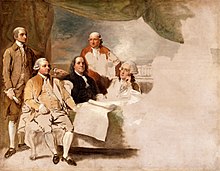Treaty of Paris (1783)
The Treaty of Paris was the treaty that formally ended the American Revolutionary War between the United Kingdom of Great Britain and the United States of America.

The treaty was signed in Paris on September 3, 1783. The American Congress of the Confederation ratified the treaty on January 14, 1784. The British King George III ratified the treaty on April 9, 1784.
Under the terms of the treaty, Britain recognized the new nation, agreed to remove all troops, and set new borders of the United States. The United States agreed to allow British troops to leave and to encourage the states pay all debts owed to Britain. It also agreed not to persecute the Tories (people loyal to the British king and so also known as loyalists) still in the United States and allow those who left America to return.[1]
France and Spain, who were allies of the United States, also signed peace treaties with Britain. France got Tobago and Senegal and some other places. Spain wanted Gibraltar but instead got Menorca and Florida. The Netherlands, which signed later, did not gain or lose land but were forced to allow British trade in the Dutch East Indies.
In India, the Kingdom of Mysore, which was supported by the French until the treaty was signed, continued fighting for another year but also neither gained nor lost any land.
Related articles change
References change
- ↑ "Treaty of Paris, 1783". United States Department of State. Archived from the original on 2015-04-02. Retrieved 2010-01-29.